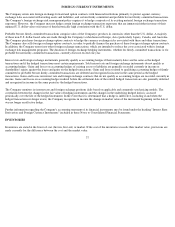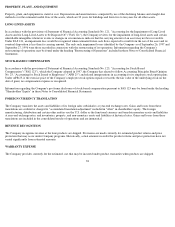Apple 1997 Annual Report Download - page 40
Download and view the complete annual report
Please find page 40 of the 1997 Apple annual report below. You can navigate through the pages in the report by either clicking on the pages listed below, or by using the keyword search tool below to find specific information within the annual report.FOREIGN CURRENCY INSTRUMENTS
The Company enters into foreign exchange forward and option contracts with financial institutions primarily to protect against currency
exchange risks associated with existing assets and liabilities, and certain firmly committed and probable but not firmly committed transactions.
The Company's foreign exchange risk management policy requires it to hedge a majority of its existing material foreign exchange transaction
exposures. However, the Company may not hedge certain foreign exchange transaction exposures that are immaterial either in terms of their
minimal U.S. dollar value or in terms of their historically high correlation with the U.S. dollar.
Probable but not firmly committed transactions comprise sales of the Company's products in currencies other than the U.S. dollar. A majority
of these non-U.S. dollar-based sales are made through the Company's subsidiaries in Europe, Asia (particularly Japan), Canada, and Australia.
The Company purchases foreign exchange option contracts to hedge the currency exchange risks associated with these and other transactions.
The Company also sells foreign exchange option contracts, in order to partially finance the purchase of these foreign exchange option contracts.
In addition, the Company enters into other foreign exchange transactions, which are intended to reduce the costs associated with its foreign
exchange risk management programs. The duration of foreign exchange hedging instruments, whether for firmly committed transactions or for
probable but not firmly committed transactions, currently does not exceed one year.
Interest rate and foreign exchange instruments generally qualify as accounting hedges if their maturity dates are the same as the hedged
transactions and if the hedged transactions meet certain requirements. Sold interest rate and foreign exchange instruments do not qualify as
accounting hedges. Gains and losses on accounting hedges of existing assets or liabilities are generally recorded currently in income or
shareholders' equity against the losses and gains on the hedged transactions. Gains and losses related to qualifying accounting hedges of firmly
committed or probable but not firmly committed transactions are deferred and recognized in income in the same period as the hedged
transactions. Gains and losses on interest rate and foreign exchange contracts that do not qualify as accounting hedges are recorded currently in
income. Gains and losses on accounting hedges realized before the settlement date of the related hedged transaction are also generally deferred
and recognized in income in the same period as the hedged transactions.
The Company monitors its interest rate and foreign exchange positions daily based on applicable and commonly used pricing models. The
correlation between the changes in the fair value of hedging instruments and the changes in the underlying hedged items is assessed
periodically over the life of the hedged instrument. In the event that it is determined that a hedge is ineffective, including if and when the
hedged transactions no longer exists, the Company recognizes in income the change in market value of the instrument beginning on the date it
was no longer an effective hedge.
Further information regarding the Company's accounting treatment of its financial instruments may be found under the heading "Interest Rate
Derivatives and Foreign Currency Instruments" included in these Notes to Consolidated Financial Statements.
INVENTORIES
Inventories are stated at the lower of cost (first-in, first-out) or market. If the cost of the inventories exceeds their market value, provisions are
made currently for the difference between the cost and the market value.
37
























